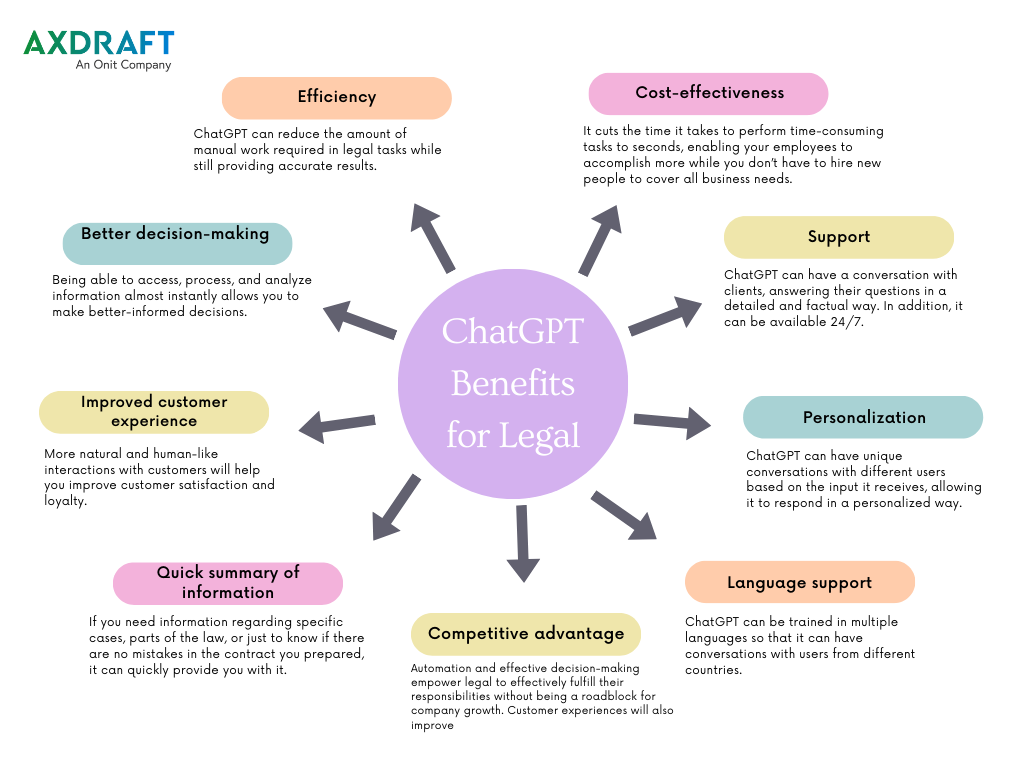Got no time to read? Listen to our blog on the go
You’ve probably heard about ChatGPT – it’s still one of the hottest topics of today.
You ask it to write about a certain topic, and it does. It’s a nice tool for copywriters and journalists, but if you think it won’t help you unless you’re a writer, think again.
GPT-3 (which is the tech behind ChatGPT) is a disruptive technology that many industries can benefit from. It’s been trained to comprehend what humans mean when they ask a question (and sometimes understand it even better than humans 😅). But the important takeaway is that it’s capable of more than just creating copy.
It can also elevate automation to a new level and become an indispensable assistant for legal professionals.
Let’s dig deep and explore what’s so disruptive about this technology.
An AI Game-Changer
GPT-3 is the largest language model at the moment. It has 175 billion parameters and was trained on 570 gigabytes of text. It can recognize, summarize, translate, predict, and generate text and other content based on knowledge derived from massive datasets. ChatGPT is based on GPT-3, and currently it’s the most powerful AI system in the world.
As for how GPT-3 works, let it speak for itself. Here’s how ChatGTP describes itself:
GPT-3, or Generative Pretrained Transformer 3, is a powerful language processing tool developed by OpenAI. It is a type of artificial intelligence (AI) that is designed to understand and generate natural human language. GPT-3 can be used for a wide range of tasks, such as generating text, answering questions, and translating languages. It is considered to be one of the most advanced language-processing AI systems in the world and is capable of providing highly accurate and realistic responses to a wide range of inputs. Overall, GPT-3 is a remarkable example of the power of AI to understand and generate human language.
Going a bit further, here’s what GPT-3 AI presented by Midjourney generated when given these prompts:
- ‘How GPT-3 AI sees itself’

- ‘How CPT-3 AI wants humans to see it’

But it’s not just the unusually large set of capabilities that makes GPT-3 special, but the fact that they aren’t fully discovered yet. For now, it can write content, generate code, create websites, and much more, making it difficult to outline all possible uses of GPT-3, as well as its potential influence on society.
For example, by using large language models, AI systems can learn medicine, biology, and chemistry, dive deep into topics, and suggest new ways of treating known diseases or creating a new cure. Or it can learn the law and suggest paths to solving a legal case you’re working on.
Unlike AI models that are trained to solve certain problems, ChatGPT can learn. Moreover, it can learn not only from the dataset provided, but also from user feedback.
How to use ChatGPT in legal ops
90% of legal professionals believe that legal tech is important for meeting their client’s needs and improving their services. However, sophisticated AI models like ChatGTP are not that popular among law firms and in-house legal departments. The reason for it may be that they just don’t know or didn’t thoroughly consider this tool.
Information at your fingertips has just taken a giant leap forward. Use it. — Kumar Mehta, Forbes
Nevertheless, ChatGPT opens up several possibilities for legal operations to speed up and scale their day-to-day work. Here’s a closer look at some of the biggest use cases:
- Document drafting: GPT-3 can create legal documents in seconds. It saves time, eliminates errors, and streamlines the process.
- Document review: Instead of spending hours reviewing a large contract, lawyers can receive information about risky clauses, possible ambiguities, or non-compliance with company needs or regulations of the relevant country. .
- Analytics: Large batches of contracts can be analyzed much faster using this technology. Then lawyers can use the information to find the best way to act.
- Reports: After the analysis, AI can use the needed metrics and transform data into structured reports. Thus, you can easier and faster get information on your performance and present them to the board.
- Case law analysis: For young professionals or those who work in specialized areas of law, it will be helpful to have an AI assistant trained on a large corpus of case law. Then they can use it to quickly and accurately identify relevant cases and legal precedents.
- Data insights: Another benefit of training ChatGPT on a large dataset of legal documents is that it can identify the sentiment in the document. This can be used to spot problematic language or assess a law to see if it favors a specific stipulation or not.
- Legal advice: You can ask ChatGPT a question, and it can answer you with efficient legal advice. It may also reduce the cost of legal services.
- Language simplification: ChatGPT is able to simplify legalese so that non-lawyers can understand a contract’s contents. Consequently, not only does this allow legal teams to delegate simple contracting to non-legal teams, but it also frees up lawyers from constantly having to explain the essentials.
- Translations: It can assist with legal translations by providing accurate translations of documents from one language to another.
- Predictive analysis: Using historical data, GPT-3 can predict a potential outcome for future cases or particular decisions and actions.
- Structuring cases and documents: The tool can be taught to identify key features of particular inquiries and assign responsibility to a person, indicate a priority level to certain cases, or just put some documents into a folder dedicated to a particular project.
- Document search: ChatGPT is capable of dramatically reducing the amount of time spent on tedious document searches, letting you focus more on analyzing and less on scouring the internet.
- In-house client communications: ChatGPT’s very nature as a chatbot capable of processing and producing human-like text makes it well-suited for providing the first line of addressing internal questions. It can respond to and clarify an internal client’s or stakeholder’s initial questions. If it’s unable to find the answer, it can be configured to forward the client or stakeholder to a member of the legal team.

A properly fine-tuned ChatGPT can be integrated into legal workflows and assist your legal department in different tasks. It’s a valuable tool that can learn and greatly improve your performance, but it needs human oversight. In other words, you won’t be replaced by robots.
Benefits
ChatGPT is an excellent tool that can be used to make your firm more productive. Many startups and well-known organizations in various industries already rely on ChatGPT daily. Here are some benefits ChatGPT can provide:
- Efficiency: ChatGPT can reduce the amount of manual work required in legal tasks while still providing accurate results.
- Cost-effectiveness: GPT-3 allows you to automate part of your day-to-day responsibilities, such as creating templates, drafting clauses, contract reviews, or answering client requests. It cuts the time it takes to perform time-consuming tasks to seconds, enabling your employees to accomplish more while you don’t have to hire new people to cover all business needs.
- Support: ChatGPT can have a conversation with clients, answering their questions in a detailed and factual way. This way, many legal requests from your clients can be solved without the involvement of a human. The program will redirect only complex requests to a real person. In addition, it can be available 24/7, which is convenient when users need assistance outside of regular business hours (i.e., if they are in another time zone, they won’t have to wait until you wake up with some minor issue).
- Personalization: ChatGPT can have unique conversations with different users based on the input it receives, allowing it to respond in a personalized way. Then your clients will get the needed help without the feeling of talking to a robot.
- Language support: ChatGPT can be trained in multiple languages so that it can have conversations with users from different countries. It can improve relations with foreign clients as it mitigates the risk of misunderstanding. Also, you won’t have to look for a specialized translator each time you need to explain some legal nuances to your client from abroad.
- Quick summary of information: If you need information regarding specific cases, parts of the law, or just to know if there are no mistakes in the contract you prepared, it can quickly provide you with it. That’s much faster than doing research and analytics yourself.
- Improved customer experience: More natural and human-like interactions with customers will help you improve customer satisfaction and loyalty.
- Better decision-making: Being able to access, process, and analyze information almost instantly allows you to make better-informed decisions. It will help you find the best ways to deal with cases you’re working on, decide how to improve your workflow, determine which contracts you should focus on, or find solutions to operating in a new country while staying 100% compliant with regulations.
- Competitive advantage: Automation and effective decision-making empower legal to effectively fulfill their responsibilities without being a roadblock for company growth. Customer experiences will also improve. This will distinguish you on the market, giving you a competitive edge over other players.

With a wide range of potential applications, ChatGPT can be used in different industries to enhance and improve products and services. For Legal, it can have a significant positive impact and revolutionize the way lawyers do their jobs.
Limitations
By providing AI with data, we can teach it a lot of things. However, it can’t think like people do, and that’s why it can only operate in the frames we set. ChatGTP may become a very powerful and extremely useful assistant for you, but it has its limitations.
- Convincing but wrong: ChatGPT can write perfect, grammatically correct text, but sometimes it may be flat-out wrong. Yes, the text is written faster, but it’s important to have a human double-check.
- It doesn’t teach itself: We give a dataset to a program, and it can make predictions based on the data. It analyzes the data and makes decisions according to its algorithms.
- Limited understanding of context: ChatGPT can generate text that flows naturally and provides you with advice. But the answer will be based on what it can find on the internet, and it can’t always explain why a certain request results in a specific answer. Without understanding the legal meaning, it may not fully satisfy your need.
- Lack of empathy: A machine learning model cannot understand what others feel. It can be used in support services, but it can’t provide an empathetic or emotional conversation.
- Limited creativity: The system can suggest ideas based on existing information and solutions that someone has already used. This is helpful, but that means it’s limited in providing original ideas.
- Dependence on data quality: The quality of the content generated is greatly dependent on what ChatGTP is trained on. If the data has grammatical mistakes or is biased, the same issues may appear in generated content as well.
These drawbacks don’t make ChatGPT bad. They’re just areas to improve on.
ChatGPT may require a bit of active supervision, but it’s already an invaluable assistant.
GPT-3 Features in AXDRAFT
AXDRAFT contains two features that leverage the capabilities of GPT-3: Clause Creator and Simplify. These features may be used in the following ways.
Clause Creator
Clause Creator is a useful feature for redlining. Simply add what the clause should contain and set the maximum length. Once the clause is ready, you can review it, make edits if necessary, and then insert the clause into the document.
Using Clause Creator, both legal and non-legal teams are able to process contracts and draft legal clauses much more efficiently.
Simplify
Simplify will… well, simplify your text. To use it, just select the part of the text you want to simplify while drafting a document. GPT-3 will provide you with an easier version that you can then copy and send to whoever you need.
This delegates the explanation (and simplification) of complex legal language to AI. Your colleagues will know what’s meant, and you can focus on more important matters.
Quality Control
Remember: AI doesn’t do the entire job for you. It’s a helper.
That’s why, when using it for contract drafting, you shouldn’t accept the first draft as is unless it is – without a doubt – 1,000% perfect, suitable, and applicable to your situation.
There are many potential advantages to fine-tuning a GPT-3 model: improved accuracy, increased robustness, better generalization, and boosted interpretability. That being said, if it were easy enough to simply feed text into an algorithm and watch as the AI provides flawless text, it would have been done a long time ago.
As such, quality control measures are necessary in order to ensure that the contracts and documents generated by GPT-3 are usable.
Here are some tactics you can employ to ensure GPT-3 gets the job done the way you want it:
1. Check all text that GPT-3 produces for accuracy (especially in the early stages)
2. Check the prompts used
- Does the prompt have clear instructions?
- Is the prompt simple and uncomplicated?
- Does the prompt use any keywords to ensure content is relevant?
- Do the prompts contain enough context?
- Are the prompts too long? Can they be shortened?
3. Check the data set
- Are the samples high quality?
- Are the samples representative of the target goal?
- Do the samples need any editing?
- How should the samples be changed to improve accuracy?
- Should the sample set be adjusted (i.e. samples swapped in and out)?
4. Check the outputs
- Do the outputs achieve their objective?
- Are variables mapped incorrectly in samples?
- What are the issues with the outputs?
- Are the outputs too long? How can they be shortened?
- How unique is the text?
This checklist is a general list of actionable steps that you can take when implementing quality control. Most likely, this list will become much longer should you augment it to fit your own needs.
Wrapping Up
Although people may not have discovered all the possibilities and use cases for ChatGPT, we already have some very important insights on how it can be useful in Legal. As an innovative company, AXDRAFT couldn’t just pass up the opportunities it opens and (a bit of bragging) became the first legal tech company to provide the real deal, not just as a beta or prototype.
Book a demo with our team and we’ll show what AXDRAFT CLM is capable of.